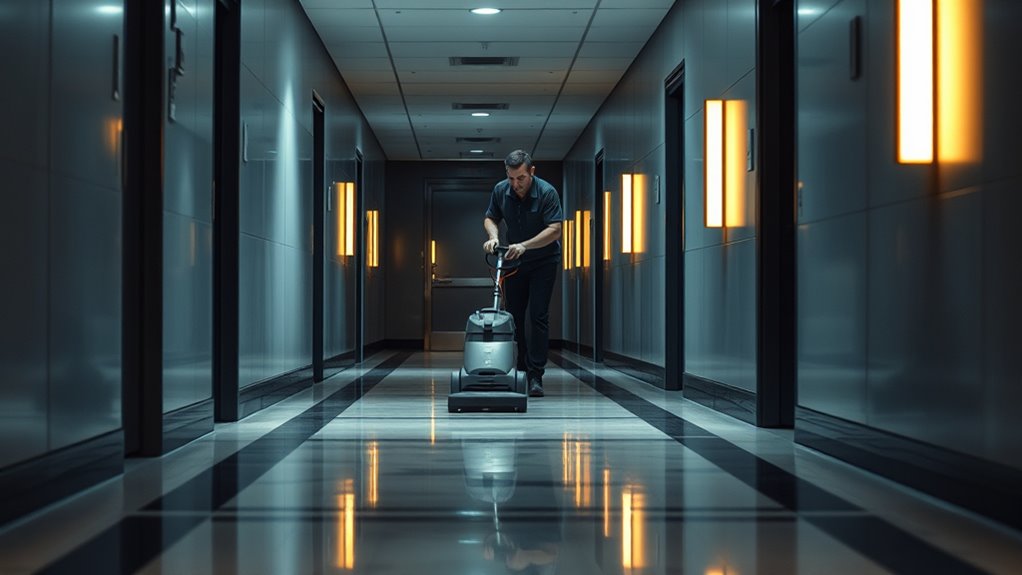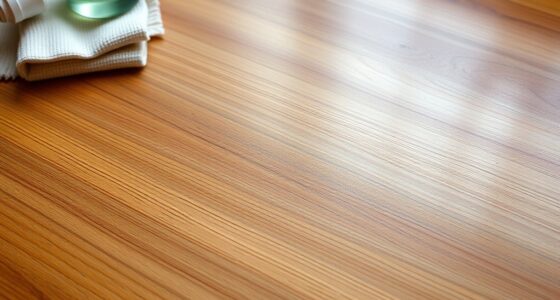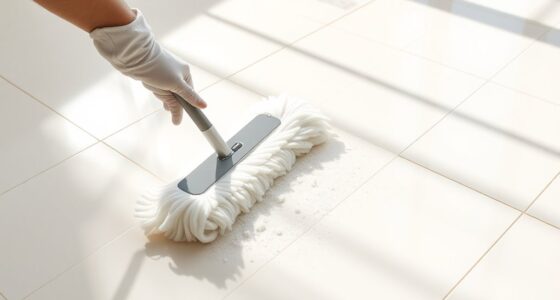To reduce noise during night cleaning, start by using sound-absorbing materials like acoustic panels, curtains, and rubber mats to dampen sound around equipment. Choose quieter, noise-reduction models and maintain them regularly. Schedule the loudest tasks during quieter hours and turn off equipment when not in use. Communicate with residents and set up noise barriers to contain sound. If you keep exploring, you’ll discover even more effective techniques to keep noise levels low.
Key Takeaways
- Use sound-absorbing materials like acoustic panels and carpets to dampen noise in cleaning areas.
- Choose quieter equipment with noise-reduction features and maintain it regularly for optimal performance.
- Schedule loud cleaning tasks during less sensitive hours and communicate with residents or staff about timing.
- Enclose noisy equipment in soundproof rooms or barriers to contain noise within designated zones.
- Implement operational techniques such as turning off equipment when not in use and using sound-dampening accessories.

Ever wonder how to keep night cleaning quiet and considerate for everyone nearby? It’s a common concern, especially in environments where noise could disturb residents or nearby businesses. The key lies in understanding and applying effective soundproofing strategies combined with managing equipment noise levels. By taking these steps, you can guarantee your cleaning efforts are both efficient and unobtrusive.
Start with soundproofing strategies that minimize the sound traveling through walls, floors, and ceilings. Using sound-absorbing materials like acoustic panels or foam can considerably reduce noise transmission. These materials are easy to install behind or around equipment and in areas where sound tends to bounce or reverberate. If possible, place soundproof curtains over cleaning stations or windows to contain noise within specific zones. Carpets or rubber mats under equipment can dampen vibrations and prevent them from amplifying sound. For particularly noisy machines, consider creating a dedicated cleaning room or enclosure, which acts as a barrier to contain equipment noise levels and prevent sound from escaping into shared spaces.
Use sound-absorbing materials and enclosures to contain noise during night cleaning.
Next, focus on managing equipment noise levels directly. Select quieter models when purchasing or upgrading cleaning machines. Modern equipment often features noise-reduction technology, such as quieter motors or insulation that minimizes sound output. When operating equipment, keep it well-maintained—regular lubrication and tune-ups can prevent unnecessary noise caused by loose or worn parts. Use equipment at the lowest effective setting; for example, if a vacuum has adjustable suction levels, dial it down during night shifts to lessen the sound footprint. Also, prioritize the timing of noisy tasks. Schedule the loudest cleaning activities during times when fewer people are affected or when background noise can mask the sound more effectively.
In addition to equipment adjustments, consider operational techniques that reduce noise impact. Turn off or pause equipment when not actively cleaning to avoid unnecessary noise. Communicate with nearby residents or colleagues about your schedule so they’re aware of when louder activities might occur and can prepare accordingly. If possible, set up designated pathways and stations away from sensitive areas to contain the noise. Using signage or indicators can remind staff to be mindful of sound levels during late hours.
Frequently Asked Questions
What Are the Best Noise-Canceling Headphones for Night Cleaning?
You should consider noise-canceling headphones with advanced noise canceling technology, like Sony WH-1000XM4 or Bose Noise Cancelling Headphones 700. Look for features such as adjustable noise cancellation, long battery life, and comfortable ear cups for extended wear during night cleaning. These headphones actively block out background noise, helping you focus and work quietly. Prioritize models with effective noise-canceling tech and user-friendly controls for the best experience.
How Can Scheduling Affect Noise Reduction Strategies?
Scheduling can greatly impact your noise reduction efforts, as studies show that proper timing adjustments can cut noise complaints by up to 30%. By coordinating your workforce effectively, you minimize overlap and ensure cleaning occurs during less sensitive hours. Strategic timing adjustments help prevent disruptions, while well-planned workforce coordination ensures cleaner, quieter nights. You’ll reduce noise levels and improve community satisfaction with thoughtful scheduling.
Are There Eco-Friendly Noise Mitigation Options?
You can use eco-friendly noise mitigation options like soundproof barriers made from recycled materials to reduce noise during night cleaning. Opt for green cleaning products that minimize chemical odors and noise from equipment. Additionally, installing temporary soundproof barriers around noisy areas helps contain sound, ensuring a quieter environment. These eco-friendly options not only cut down noise but also promote sustainability, making your cleaning process more environmentally responsible.
What Training Methods Help Workers Minimize Noise?
Ever imagine quieting a bustling site? You can train workers in effective techniques like proper equipment handling and maintenance to minimize noise. Focus on teaching worker techniques that encourage gentle operation and awareness of surroundings. Regular equipment maintenance also plays a vital role, as well-maintained tools run quieter. By emphasizing these methods, you empower your team to work efficiently while keeping noise levels down during night cleaning.
How Does Building Insulation Impact Noise Levels?
Building insulation considerably impacts noise levels by utilizing specific building materials and soundproofing techniques. When you use dense materials like mineral wool or foam panels, they absorb and block sound waves, reducing noise transmission. Proper insulation creates a barrier that keeps noise confined, making your environment quieter. To maximize noise reduction, make certain your building employs effective soundproofing techniques, such as sealing gaps and adding resilient channels, which further dampen unwanted sound.
Conclusion
By implementing these noise reduction tips, you’re well on your way to quieter nights. But remember, the true secret to maintaining peace might just lie in one unexpected change you haven’t considered yet. Will this simple adjustment make all the difference? Stay alert—sometimes, the smallest tweak can *unseal* a surprisingly tranquil environment, leaving you wondering what other quiet surprises await just around the corner. The night’s calm is closer than you think.








